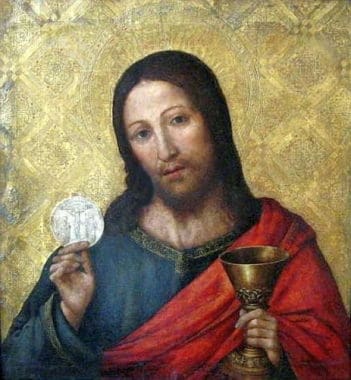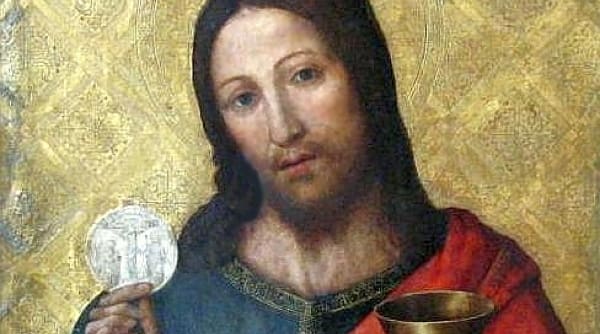Mini-Course on Prayer
Part 8 “FATHER T” – Thanksgiving
Thanksgiving, Sacrifice, and Adoration
Editor’s Note: In Part 7 of this mini-course, David Torkington examined the letters F (faith) and A (abandonment) in his explication of the “OUR FATHER” mnemonic, or memory jog, for keeping God and prayer at the forefront of our lives. Today, he continues with the letters T (thanksgiving) and H (Holy Communion).
Continuing my introduction to daily prayer by using each letter of the Our Father to remind us of the essential characteristics of all authentic Christian prayer, I now want to draw your attention to the letter – T – reminding us to thank God.
If we only thank him for what we manage to get out of him or for what he has done for us, then we have hardly begun to thank him as we should. He should be thanked for being God, for being goodness, justice, truth and beauty, for displaying his inner glory in the glory of creation that surrounds us, and for the masterpiece of creation in and through whom we are drawn up to share in his own inner life and love.
Try this Spiritual Experiment
When I first began to thank God for being God, it was as if I was raised beyond myself and into God’s world, if only for a brief moment when my prayer life reached higher peaks than ever before. If you don’t know what I mean, try this little experiment. When you have thanked God for what he has done for you, start thanking him for what he is and what he does for everyone, just by being what he is. Take your favourite prayer or hymn of thanksgiving or praise, like the Gloria from the liturgy for instance. Recite it slowly and prayerfully and you will find you are taken out of yourself, out of your world and into God’s world where you praise him, thank him, and give him glory with all those who have learned to thank God just for being God. You will find that the further you enter into his world, the more you will forget yourself and the world where you only thanked him for what you got out of him. Then you will come alive, more alive than ever before, if only for a time in the world where you want to be for all time.
Thanking God for being God leads into the heights of prayer where thanksgiving leads to praise, and praise to glorifying God. Glorifying God leads to adoration, when we just want to gaze upon him with a profound reverence and awe that takes us out of ourselves if only for a time into brief moments of rapturous bliss. Without us realising fully what has been happening, our thanksgiving, praising, glorifying and adoring has paved the way for our love to enter into God and his love to enter into us in a way and on a level that has not happened in quite the same way before.
FATHER – H – Holy Communion
When Jesus foretold that he would become the Bread of Life, he was not only referring to his presence in the Eucharist, but something further too. He was referring to his daily, moment by moment and ongoing presence, as the Bread of Life, in the lives of his followers. In short, he would become the staple diet of their daily spiritual lives. In modern times  it might be possible to interpret the words in the Lord’s Prayer, “Give us this day our daily bread,” as referring to daily Mass, but in ancient times when the norm was weekly Mass, it referred to the daily Bread of Life that was Christ himself who is prepared and poised at every moment to nourish us with the spiritual food which is nothing other than his own life and love (read John Chapter 6). This was something that can so easily be forgotten today, but it was central to the spirituality of the first Christians. At their weekly communal celebration of Mass everyone would offer their love to God together, knowing that they would receive the fullness of his love in return, in the person of Christ made present in the physical bread and wine. During the week, however, each individual would continue to offer their love to God and continually receive his love in return in the person of Christ made spiritually present, as promised by Christ himself, as the Bread of life. The measure in which they would receive Christ in this way would be determined by the measure of their selfless daily giving. This giving would be expressed in the quality of their daily prayer and in the service of others, beginning at home, where charity should always begin. This would lead to profound moments of inner peace and joy when those who gave their all paused to relish what they had received, in what came to be called spiritual communion.
it might be possible to interpret the words in the Lord’s Prayer, “Give us this day our daily bread,” as referring to daily Mass, but in ancient times when the norm was weekly Mass, it referred to the daily Bread of Life that was Christ himself who is prepared and poised at every moment to nourish us with the spiritual food which is nothing other than his own life and love (read John Chapter 6). This was something that can so easily be forgotten today, but it was central to the spirituality of the first Christians. At their weekly communal celebration of Mass everyone would offer their love to God together, knowing that they would receive the fullness of his love in return, in the person of Christ made present in the physical bread and wine. During the week, however, each individual would continue to offer their love to God and continually receive his love in return in the person of Christ made spiritually present, as promised by Christ himself, as the Bread of life. The measure in which they would receive Christ in this way would be determined by the measure of their selfless daily giving. This giving would be expressed in the quality of their daily prayer and in the service of others, beginning at home, where charity should always begin. This would lead to profound moments of inner peace and joy when those who gave their all paused to relish what they had received, in what came to be called spiritual communion.
Spiritual Communion
The letter -H- is a reminder to pause in our daily prayer in silent contemplation for a time to reflect on the Holy Communion that takes place when our daily offering enables Christ, the Bread of life, to enter in to nourish and sustain us. These precious moments when we savour in silence this mystical food without which we would languish and die, is still called spiritual communion. This is the time to ruminate on, and relish the profound mysteries that are at work deep down within us, and to digest and assimilate their sublime meaning and importance for us now and for our future. It is time too, to allow these truths to percolate through, to penetrate our hearts and minds, and then gaze for as long as possible at the indescribable mysteries that Jesus came to share with us. This is the time for us to speak with him and to share with him our most secret thoughts and desires. At the Last Supper when Jesus spoke about these sublime truths he insisted that this would be the time to ask whatever we wanted and to be assured that our prayers made in his name would be answered (read John 14:13 & 15:7). What happens in these brief moments of daily spiritual communion makes a person desire more space and time to penetrate and contemplate these sublime truths at greater length and in ever greater depth. Inevitably a person feels the deep inner pull that is at times clearly tangible, to seek out more space and time to do what we have been created for. And so we experience in some small measure what we will one day experience without measure, in our true and everlasting home from home.
These ideas are developed further in my two major works on prayer – Wisdom from the Western Isles and Wisdom from the Christian Mystics. Wisdom from Franciscan Italy shows how the mystical life is lived by St Francis of Assisi, called in his lifetime, a Second Christ.
Editor’s Note: In part 9 of this mini-course, David Torkington will look at the letters E (examination of conscience) and R (repentance) as he completes his explanation of the “OUR FATHER” mnemonic, or memory jog, for keeping God and prayer at the forefront of our lives.
+
Art for this post on thanksgiving, sacrifice, adoration, and Holy Communion: Partial Restoration of Christ with the Host, Paolo da San Leocadio, fourth quarter of 15th century, PD-US author’s life plus 100 years or less, Wikimedia Commons.





